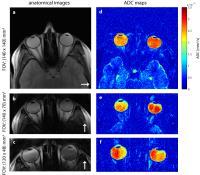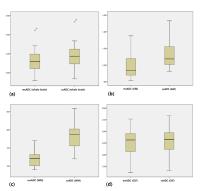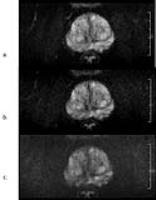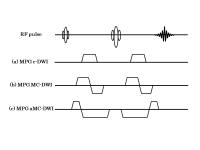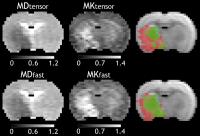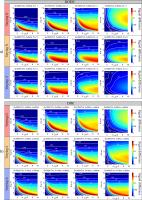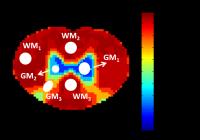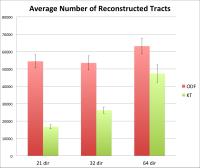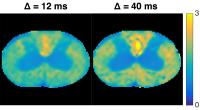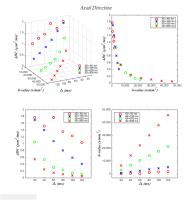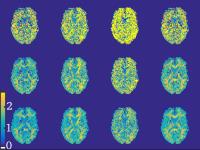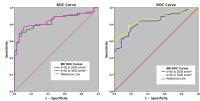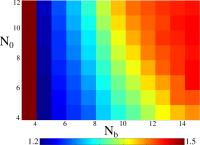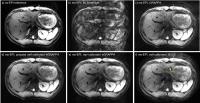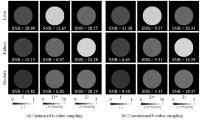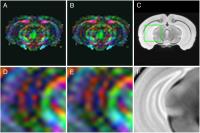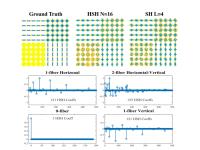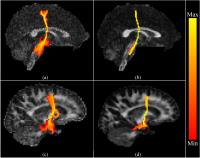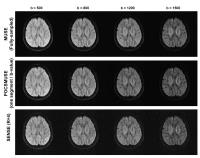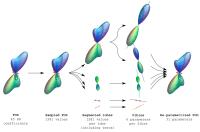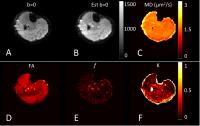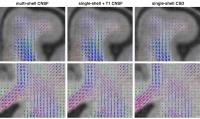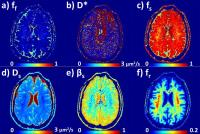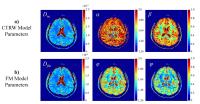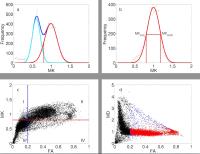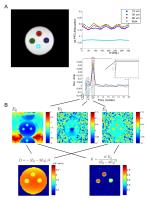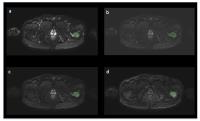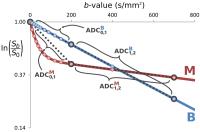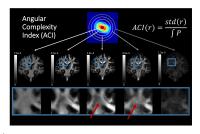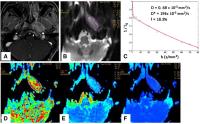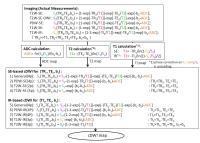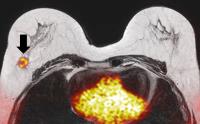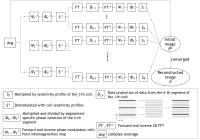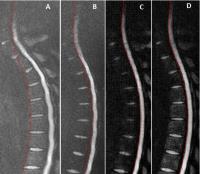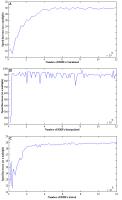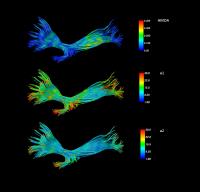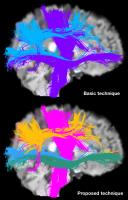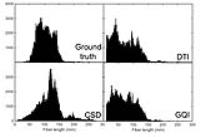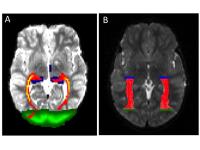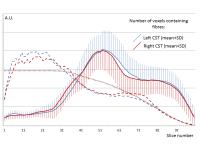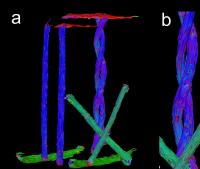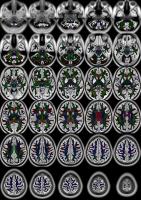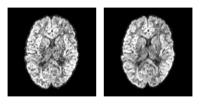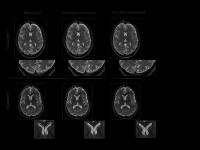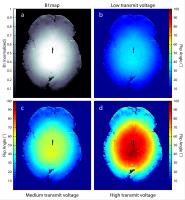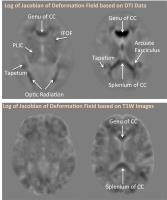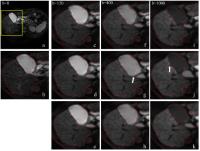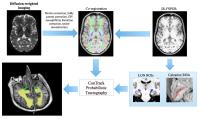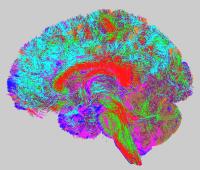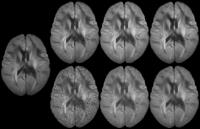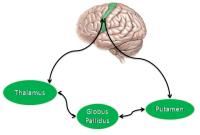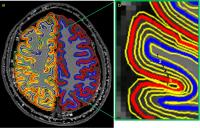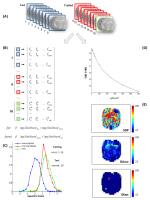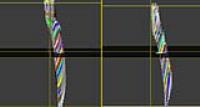|
Exhibition Hall 16:30 - 17:30 |
|
|
|
Computer # |
|
3078.
 |
73 |
Longitudinal Comparison of Diffusion Imaging Modeling in Rat
Spinal Cord Injury 
Nathan P Skinner1,2,3, Sean D McGarry4,
Shekar N Kurpad3,5, Brian D Schmit6,
and Matthew D Budde3,5
1Biophysics Graduate Program, Medical College of
Wisconsin, Milwaukee, WI, United States, 2Medical
Scientist Training Program, Medical College of Wisconsin,
Milwaukee, WI, United States,3Department of
Neurosurgery, Medical College of Wisconsin, Milwaukee, WI,
United States, 4Neuroscience
Doctoral Program, Medical College of Wisconsin, Milwaukee,
WI, United States, 5Clement
J. Zablocki Veteran's Affairs Medical Center, Milwaukee, WI,
United States, 6Department
of Biomedical Engineering, Marquette University, Milwaukee,
WI, United States
A rat model of graded spinal cord injury was used to
evaluate several diffusion models for the ability to detect
injury at acute and chronic time points. Parameters from
diffusion tensor imaging, free water estimation, diffusion
kurtosis imaging, and white matter tract integrity models
demonstrated that higher order modeling showed better
separation of injury severity, especially in the chronic
time point. Furthermore, parameters sensitive to volume
changes associated with edema and inflammation demonstrated
the greatest separation of these injury groups, indicating
the importance of these processes in altering diffusion
characteristics in spinal cord injury.
|
|
3079.
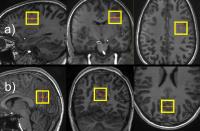 |
74 |
Intracellular metabolites exhibit non-Gaussian diffusion in the
healthy human brain using magnetic resonance spectroscopy at 7
Tesla 
Carson Ingo1, Wyger M. Brink1, Ece
Ercan1, Andrew G. Webb1, and Itamar
Ronen1
1C.J. Gorter Center for High Field MRI,
Department of Radiology, Leiden University Medical Center,
Leiden, Netherlands
Since choline mostly resides in astrocytes,
N-acetyl-aspartate mostly presides in axons, and creatine is
distributed between both neural cell types, these
intracellular metabolites can provide more specific
microstructural compartment information compared to water.
In this study, we apply diffusion-weighted spectroscopy to
analyze axonal and glial structures by identifying
non-Gaussian movement of intracellular metabolites in both
white and gray matter of the healthy human brain at b-values
up to ~17,000 s/mm2. We establish that all
measured metabolites exhibited non-Gaussian subdiffusion in
both tissue types with the gray matter intracellular space
appearing more heterogeneous than white matter, opposite to
water diffusion dynamics.
|
|
3080.
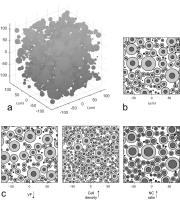 |
75 |
Relations between the stretched exponential DWI model and tumor
malignancy related microstructural changes 
Chu-Yu Lee1, Kevin M Bennett2, Josef P
Debbins3, In-Young Choi1,4,5, and Phil
Lee1,5
1Hoglund Brain Imaging Center, University of
Kansas Medical Center, Kansas city, KS, United States, 2Department
of Biology, University of Hawaii, Manoa, HI, United States, 3Neuroimaging
research, Barrow Neurological Institute, Phoenix, AZ, United
States, 4Department
of Neurology, University of Kansas Medical Center, Kansas
City, KS, United States, 5Department
of Molecular & Integrative Physiology, University of Kansas
Medical Center, Kansas City, KS, United States
Diffusion weighting imaging (DWI) has been shown to be
useful in differentiating low- and high-grade tumors in the
brain. The decreased apparent diffusion coefficient (ADC)
has been associated with increased tumor cellularity.
However, tumor malignancy involves multiple microstructural
changes that may also affect changes in the ADC. The
alternative way to assess water diffusion in the complex
microstructure is through the diffusion heterogeneity
measured by the stretched exponential model (α-DWI). Recent
studies using the α-DWI model have shown the increased
diffusion heterogeneity in high-grade tumors. However, it
remains unclear about the microstructural information
provided by the α. The purpose of this study was to
investigate how the α-DWI model responds to tumor malignancy
related microstructural changes. We simulated a 3-D
microenvironment in tumors and a DWI experiment. We studied
how ADC and the fitted parameters of the α-DWI model
responded to microstructural changes related to tumor
malignancy.
|
|
3081.
 |
76 |
Validation and comparison of diffusion MR methods measuring
transcytolemmal water exchange rate - Video Not Available
Xin Tian1,2, Hua Li1, Xiaoyu Jiang1,
Jingping Xie1, John C Gore1, and
Junzhong Xu1
1Radiology and Radiological Sciences, Vanderbilt
University, Nashville, TN, United States, 2Radiology,
The Second Hospital of Hebei Medical University,
Shijiazhuang, China, People's Republic of
Two diffusion-based method, the CG (constant gradient) and
FEXI (filtered exchange imaging) methods, have been
developed to provide a flexible and safer means to measure
transcytolemmal water exchange rate $$$k_{in}$$$
non-invasively in vivo. However, neither methods have been
fully validated up to date. In the present work, computer
simulations and in vitro experiments with well-controlled
cultured cells with different sizes and permeabilities were
performed to evaluate the accuracy of the CG and FEXI
methods. The results suggest that $$$k_{in}$$$ can be
accurately estimated when $$$k_{in}$$$ < 10 Hz. Although the
FEXI method provides less accurate results, the linear
dependence of AXR on $$$k_{in}$$$ suggesting it is still a
reliable method.
|
|
3082.
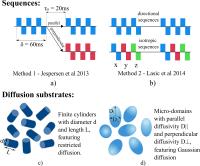 |
77 |
Metrics of microscopic anisotropy: a comparison study 
Andrada Ianu?1, Noam Shemesh2, Daniel
C. Alexander1, and Ivana Drobnjak1
1CMIC, University College London, London, United
Kingdom, 2Champalimaud
Neuroscience Programme, Champalimaud Centre for the Unknown,
Lisbon, Portugal
Microscopic anisotropy disentangles the effects of pore
shape from orientation distribution, and thus can serve as a
valuable metric for underlying microstructural
configurations. Recent developments in diffusion MRI
proposed different approaches to acquire and analyse data
for extracting information regarding microscopic anisotropy.
This work compares in simulation two recently introduced
metrics of microscopic anisotropy: fractional eccentricity
(FE), derived from double-diffusion-encoding (DDE) sequences
and microscopic fractional anisotropy (μFA), derived from a
combination of sequences with isotropic and directional
diffusion weighting. We find that DDE-derived metrics are
more reliable for quantifying underlying microstructures if
diffusion is restricted, while μFA is closer to the ground
truth values when individual micro-domains feature Gaussian
diffusion.
|
|
3083.
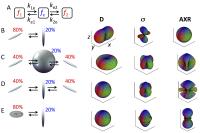 |
78 |
Apparent Exchange Rate in Multi-compartment Anisotropic Tissue - Permission Withheld
Samo Lasic1, Sune N. Jespersen2,3,
Henrik Lundell4, Markus Nilsson5, Tim
B. Dyrby4, and Daniel Topgaard6
1CR Development, AB, Lund, Sweden, 2CFIN/MINDLab,
Department of Clinical Medicine, Aarhus University, Arhus,
Denmark, 3Department
of Physics and Astronomy, Aarhus University, Arhus, Denmark,4Danish
Research Centre for Magnetic Resonance, Copenhagen
University Hospital, Hvidovre, Copenhagen, Denmark, 5Lund
University Bioimaging Center, Lund University, Lund, Sweden, 6Physical
Chemistry, Lund University, Lund, Sweden
Filter exchange imaging (FEXI) is a noninvasive method to
probe Apparent Exchange Rate (AXR). Understanding how
diffusion anisotropy affects AXR is fundamental in
experimental design and interpretation of results. In case
of only two compartments, AXR is isotropic regardless of
diffusion anisotropy. The key finding of this work is that
AXR is anisotropic even in systems with a single exchange
rate if there are more than two orientationally dispersed
compartments. These findings may guide identification of
different fiber populations and their directions and could
be useful for analysis of fiber-specific characteristics.
|
|
3084.
 |
79 |
Simulating axon packing for investigating white matter tissue
characteristics with diffusion MRI 
Hamed Y. Mesri1, Dmitry S. Novikov2,
Max A. Viergever1, and Alexander Leemans1
1Image Sciences Institute, University Medical
Center Utrecht, Utrecht, Netherlands, 2Bernard
and Irene Schwartz Center for Biomedical Imaging, Department
of Radiology, New York University School of Medicine, New
York, NY, United States
A novel algorithm for simulating axon packing in nerve
bundles is proposed. Statistical analysis of the results
demonstrates that, in contrast to conventional methods, the
proposed method eliminates the bias in the estimated
distribution and achieves higher packing densities, while
preserving the random nature of the axon packing structure.
The resultant tissue models can be used subsequently to
study the Brownian motion of water molecules within nerve
bundles. With our novel axon packing simulation framework,
the effect of axon properties on the derived
diffusion-weighted MR signal can be investigated more
reliably now.
|
|
3085.
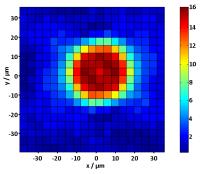 |
80 |
Magnetic Resonance Diffusion Pore Imaging on Preclinical
9.4T-Animal-Scanner 
Marco Bertleff1, Sebastian Domsch1,
Frederik Laun2, Tristan Kuder2, and
Lothar Schad1
1Computer Assisted Clinical Medicine, Heidelberg
University, Medical Faculty Mannheim, Mannheim, Germany, 2Department
of Medical Physics in Radiology, German Cancer Research
Center (DKFZ), Heidelberg, Germany
The study of porous microstructures is of high interest in
medical imaging. Diffusion pore imaging (DPI) has recently
been proposed as a means to acquire images of the average
cell shape in a voxel or region of interest. In this work,
we present the feasibility of DPI phantom measurements on a
preclinical 9.4T animal scanner for the first time and
preliminarily compare two different sequence
implementations. The shown feasibility on a preclinical
system opens the possibility of a potential in-vivo
measurement realization.
|
|
3086.
 |
81 |
Diffusion microstructure in the population: variability and
effect size of biophysical compartment model parameters over 100
subjects 
Robbert Harms1, Rainer Goebel1, and
Alard Roebroeck1
1Maastricht University, Maastricht, Netherlands
Statistical power in neuroscience studies is often limited,
leading to, among others, low reproducibility of results[1].
Robust effect size estimates over a large subject group are
crucial for power assessments. Here, we computed these
estimates for microstructural differences in splenium, body
and genu of the Corpus Callosum (CC) using diffusion MRI
microstructure modeling over 100 subjects. We fitted Tensor,
Ball&Stick, NODDI and CHARMED using GPU-accelerated software
(MDT) and extracted subject specific parameters for the CC
for each model. We observe medium to large effect sizes
(Cohen’s d=1-3) for dMRI microstructure measures, promising
for power and reproducibility of dMRI microstructure
studies.
|
|
3087.
|
82 |
Obtaining geometrical information from the time-dependent
apparent diffusion coefficient 
Simona Schiavi1, Houssem Haddar1, and
Jing-Rebecca Li1
1CMAP, INRIA, Ecole Polytechnique, Palaiseau
Cedex, France
Diffusion MRI (dMRI) has been established as a useful tool
to obtain voxel-level information on the tissue
micro-structure. An important quantity measured in dMRI is
the apparent diffusion coefficient (ADC), and it has been
well established by in-vivo brain imaging experiments that
the ADC depends significantly on the diffusion time. We
derive an explicit formula for the time-dependent ADC, and,
using the ADCs at multiple diffusion times and gradient
directions, we estimate the surface to volume ratio, the
eigenvalues and the first moment of the dominant
eigen-functions associated to the geometry of the biological
cells.
|
|
3088.
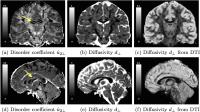 |
83 |
Precise Inference of Cellular and Axonal Structural Organization
(PICASO) using diffusion MRI 
Lipeng Ning1,2, Carl-Fredrik Westin1,2,
and Yogesh Rathi1,2
1Brigham and Women's Hospital, Boston, MA, United
States, 2Harvard
Medical School, Boston, MA, United States
We propose a novel model termed PICASO for investigating the
microstructural layout of brain tissue using in vivo
diffusion MRI (dMRI) measurements. Our method provides a
direct connection between the structural organization of
biological tissue and a function representing the disorder
in the evolution of magnetization density. This is achieved
by extending the Bloch-Torrey equation to include
variability in diffusivity due to restrictions and
hindrances. Using in vivo data from the Humman Connectome
Project (HCP), we show that the PICASO model can provide
novel information about the microstructural layout of the
axonal packing in human brain. Thus, our method can be
applied in clinical settings to investigate brain
abnormalities.
|
|
3089.
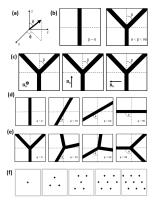 |
84 |
Simulation study investigating the effect of diffusion,
susceptibility, and vessel topology in characterizing normal and
tumorous vasculature using R2* 
Mohammed Salman Shazeeb1,2, Jayashree
Kalpathy-Cramer1, and Bashar Issa2
1Athinoula A. Martinos Center for Biomedical
Imaging, Massachusetts General Hospital and Harvard Medical
School, Boston, MA, United States, 2Department
of Physics, UAE University, Al-Ain, Abu Dhabi, United Arab
Emirates
Brain vasculature is conventionally represented as straight
cylinders when simulating BOLD contrast effects in fMRI. In
reality, the vasculature is more complicated with branching
and coiling especially in tumors. We applied a cylinder fork
model to reflect the bifurcation, tortuosity, and size of
vessels and performed simulations to study the effect of the
rotation angle (?) on R2* at different bifurcation angles
(β), vessel diameters, diffusion constants, and
susceptibility values. This model clearly showed an R2*
dependence on ?, which could potentially be used as a tool
to differentiate between normal and tumor vessels.
|
|
3090.
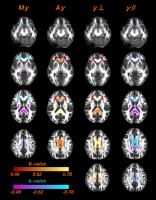 |
85 |
Anomalous diffusion parameters are sensible to microstructural
variations in brain due to aging 
Michele Guerreri1,2, Alessandra Caporale1,2,
Marco Palombo1,3, Ivan De Berardinis1,
Emiliano Macaluso4, Marco Bozzali4,
and Silvia Capuani1
1Department of physics, CNR ISC UOS Roma
Sapienza, Rome, Italy, 2Department
of anatomical, histological, forensic and of the locomotor
system science, Morphogenesis & Tissue Homeostasis, Sapienza
University, Rome, Italy, 3MIRCen,
CEA/DSV/I2BM, Fontenay-Aux Roses, France, 4Neuroimaging
Laboratory, Santa Lucia Foundation, Rome, Italy
We investigated the anomalous diffusion (AD) stretched
exponential γ-imaging model to overcome the sensitivity
limitations of conventional DTI approach based on the
assumption of the Gaussian model with regard of
displacements of water molecules in tissues. The benefits of
this approach are illustrated with an in-vivo diffusion
study of the human brain performed on 18 healthy volunteers
in the age range (23-70 years). Mean γ (Mγ) and anisotropic
γ (Aγ) maps are obtained and compared with DTI maps. The
current study suggests that Mγ and Aγ are more sensitive to
micro-structural changes caused by normal aging, compared to
DTI metrics.
|
|
3091.
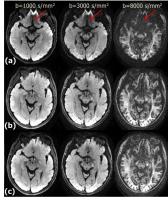 |
86 |
Diffusion Microstructure Imaging With High-Performance Head-Only
Gradient: Preliminary Results 
Ek T Tan1, Jonathan I Sperl2, Miguel
Molina Romero2,3, Seung-Kyun Lee1,
Matt A Bernstein4, and Thomas KF Foo1
1GE Global Research, Niskayuna, NY, United
States, 2GE
Global Research, Munich, Germany, 3Technical
University of Munich, Munich, Germany, 4Mayo
Clinic, Rochester, MN, United States
A high-performance head-only gradient coil (Gmax=80
mT/m, SR=700 T/m/s) allows diffusion imaging at
substantially shorter echo-time and echo-spacing than
conventional whole-body gradient coil systems. This greatly
benefits microstructure imaging with diffusion EPI,
providing reduced echo spacing by up-to two-fold and shorter
TE by up-to 30%. Imaging results demonstrate reduced
distortion and improved white matter SNR. Preliminary
results on axonal radius mapping with high b-value imaging
(up-to b=12,000 s/mm2) demonstrate the
feasibility of 2 mm-isotropic imaging with the
head-gradient.
|
|
3092.
|
87 |
Quantifying White Matter Microstructure with a Unified
Spatio-Temporal Diffusion Weighted MRI Continuous Representation 
Demian Wassermann1, Alexandra Petiet2,
Rutger Fick1, Mathieu Santin2,
Anne-Charlotte Philippe 2,
Stephane Lehericy2, and Rachid Deriche1
1Athena, Inria, Sophia-Antipolis, France, 2CENIR,
Brain and Spine Institute, Paris, France
A current problem Diffusion MRI (dMRI) based microscopy
faces under the narrow pulse approximation is how to best
exploit the 4D (q-space + diffusion time) nature of the
signal. Assaf et al. showed that exploring the dMRI
attenuation at different diffusion times provides
information on the apparent distribution of axonal diameters
within a voxel in their seminal work: AxCaliber1.
However, AxCaliber requires knowing beforehand the
predominant orientation of the axons within the analyzed
volume to adjust the q-space sampling accordingly. In this
work, we show that our novel sparse representation of the
3D+t dMRI signal2 enables the recovery of axonal
diameter distribution parameters with two main advantages.
First, it doesn't require knowledge of the predominant
axonal direction at acquisition time. Second, using the
hypothesised dMRI signal symmetry, it allows computing the
average attenuation on the plane perpendicular to the
predominant axonal direction analytically. Hence, it takes
advantage of the full 3D+t signal information to fit the
AxCaliber model.
|
 |
3093.
 |
88 |
Cytoarchitectonic abnormalities along white matter pathways in
temporal lobe epilepsy: Combining diffusional kurtosis imaging
and automated fiber quantification - Permission Withheld
Russell Glenn1, Jens H Jensen1, Simon
S Keller2, Joseph A Helpern1, and
Leonardo Bonilha3
1Medical University of South Carolina,
Charleston, SC, United States, 2University
of Liverpool, Liverpool, United Kingdom, 3Charleston,
SC, United States
Temporal lobe epilepsy (TLE) is the most common form of
medically refractory epilepsy and is associated with focal
brain abnormalities causing recurrent, unprovoked seizures
originating from the temporal lobe. However,
cytoarchitectronic changes can be detected outside of the
temporal lobe and may be associated with the clinical course
of the disease. We implement a novel neuroimaging approach
which combines the strengths of diffusional kurtosis imaging
and automated fiber quantification for the non-invasive
characterization of white matter pathways and demonstrate
its sensitivity to detect pathological alterations
associated with TLE. The proposed technique may provide
further insights into the clinicopathology of TLE.
|
|
3094.
 |
89 |
Short-term mindfulness-based stress reduction training increases
tract integrity in right auditory radiation and anterior and
posterior commissures 
Chang-Le Chen1, Yao-Chia Shih2,
Tzung-Kuen Wen3, Shih-Chin Fang4,
Da-Lun Tang5, Si-Chen Lee6, and
Wen-Yih Isaac Tseng1,7,8
1Graduate Institute of Brain and Mind Sciences,
National Taiwan University College of Medicine, Taipei,
Taiwan, 2Institute
of Biomedical Engineering, National Taiwan University,
Taipei, Taiwan,3Department of Buddhist Studies,
Dharma Drum Institute of Liberal Arts, New Taipei City,
Taiwan, 4Department
of Neurology, Cardinal Tien Hospital Yonghe Branch, New
Taipei City, Taiwan, 5Department
of Mass Communication, Tamkang University, Taipei, Taiwan, 6Department
of Electrical Engineering, National Taiwan University,
Taipei, Taiwan, 7Institute
of Medical Device and Image, National Taiwan University
College of Medicine, Taipei, Taiwan, 8Molecular
Imaging Center, National Taiwan University, Taipei, Taiwan
Mindfulness-based stress reduction (MBSR) is an 8-week
mindfulness meditation training which exerts beneficial
effects on physical and mental health. Many researches
showed that the changes in brain structure were related to
mindfulness meditation. However, few studies have
investigated the relationships between short-term
mindfulness meditation and altered white matter tracts.
Therefore, a longitudinal study was designed in this study
to identify the effects of 8-week MBSR program on white
matter tract integrity. We found that there was significant
difference in three white matter tracts, right auditory
radiation, anterior commissure and posterior commissure, in
the novice practitioners.
|
|
3095.
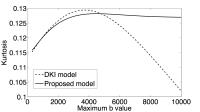 |
90 |
A physically-constrained model for diffusion kurtosis imaging 
Darryl McClymont1, Irvin Teh1, Hannah
Whittington1, Vicente Grau2, and
Jurgen Schneider1
1Division of Cardiovascular Medicine, University
of Oxford, Oxford, United Kingdom, 2Department
of Engineering Science, University of Oxford, Oxford, United
Kingdom
Diffusion kurtosis imaging provides higher-order information
about diffusion. However, the quadratic term in the
diffusion kurtosis model produces undesirable behaviour at
high b-values as a result of the negative tails of the
diffusivity distribution. A truncated normal distribution
has been proposed to address this in one dimension. This
work extends this concept to a multivariate truncated normal
distribution, and extends the range of b-values over which
kurtosis can be estimated. The proposed model is fit to
diffusion data from rat hearts, and yields kurtosis values
that are consistent with the DKI model.
|
|
3096.
 |
91 |
Intravoxel Incoherent Motion in Normal Pituitary Gland: Initial
Study with Turbo Spin-echo Diffusion-weighted Imaging - Permission Withheld
Kiyohisa Kamimura1, Masanori Nakajo1,
Yoshihiko Fukukura1, Takashi Iwanaga2,
Tomonori Saito2, Masashi Sasaki2,
Takuro Fujisaki2, Atsushi Takemura3,
Tomoyuki Okuaki 3,
and Takashi Yoshiura1
1Radiology, Kagoshima University Medical and
Dental Hospital, Kagoshima, Japan, 2Clinical
Engineering Department Radiation Section, Kagoshima
University Hospital, Kagoshima, Japan, 3Philips
Electronics Japan, Tokyo, Japan
Our purpose was to evaluate the feasibility of intravoxel
incoherent motion (IVIM) assessment based on turbo spin-echo
diffusion-weighted imaging (TSE-DWI) in the normal pituitary
gland. In a validation study using normal brain white matter
(WM), Bland-Altman analyses revealed fair to good agreement
with conventional echo-planar-based DWI (EP-DWI) in the true
diffusion coefficient (D) and perfusion fraction (f). In 7
volunteers, both D and f in the anterior pituitary lobe were
significantly higher than those in WM, being consistent with
high microvascular density in the pituitary gland. Results
demonstrated that IVIM assessment based on TSE-DWI in the
pituitary gland is feasible.
|
|
3097.
 |
92 |
White Matter Asymmetry During Development Using Diffusion
Kurtosis Imaging - Permission Withheld
Xiang Gao1, Farida Grinberg1,2,
Ezequiel Farrher1, Fei Li1, Eileen
Oberwelland3,4, Irene Neuner1,5,6,
Kerstin Konrad4,6,7, and N.Jon. Shah1,2,6
1Institute of Neuroscience and Medicine - 4,
Forschungszentrum Juelich GmbH, Juelich, Germany, 2Department
of Neurology, Faculty of Medicine, RWTH Aachen University,
Aachen, Germany,3Translational Brain Research in
Psychiatry and Neurology, Department of Child and Adolescent
Psychiatry, Psychosomatics and Psychotherapy, RWTH Aachen
University, Aachen, Germany, 4Institute
of Neuroscience and Medicine - 3, Forschungszentrum Juelich
GmbH, Juelich, Germany, 5Department
of Psychiatry, Psychotherapy and Psychosomatics, RWTH Aachen
University, Aachen, Germany, 6JARA
- BRAIN, Translational Medicine, Juelich, Germany, 7Child
Neuropsychology Section, Department of Child and Adolescent
Psychiatry, Psychosomatics and Psychotherapy, RWTH Aachen
University, Aachen, Germany
We compare changes in the white matter asymmetry index in
conventional fractional anisotropy (FA) and other diffusion
kurtosis imaging (DKI) metrics in adults and children. For
some fibres, such as cingulate gyrus, hippocampus and
superior longitudinal fasciculus, other DKI parameters show
significant asymmetry where FA fails. When compared to
adults, children showed more laterality in cingulate gyrus,
superior longitudinal fasciculus and superior longitudinal
fasciculus in temporal parts, which indicate that the degree
of asymmetry in these fibres is higher during childhood.
|
|
3098.
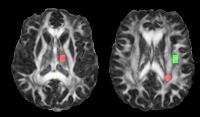 |
93 |
Anisotropy measure from High angular resolution diffusion
imaging Data Using Higher Order Diffusion Tensor model 
Getaneh Bayu Tefera1 and
Ponnada A. Narayana1
1Diagnostic & Interventional Imaging, University
of Texas at Houston, Houston, TX, United States
Different anisotropy indices such as generalized anisotropy
(GA) and generalized fractional anisotropy (GFA) for HARDI
data have been reported, but they have their own
limitations. Here we propose a new anisotropy measure (HFA)
for the HARDI data that is rotationally invariant. The new
proposed measure is compared with GA and GFA using the
contrast-to-noise ratio and coefficient of variation as the
metrics for three white matter regions. HFA and GFA have
shown better CNR than FA and GA in two and three crossing
regions. The results described above were very similar
across all the five subjects.
|
|
3099.
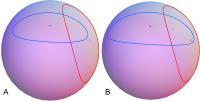 |
94 |
Tract Orientation and Angular Dispersion Deviation Indicator
(TOADDI): A framework for single-subject analysis in diffusion
tensor imaging 
Cheng G. Koay1,2, Ping-Hong Yeh2,3,
John M. Ollinger2, M. Okan Irfanoglu1,3,
Carlo Pierpaoli1, Peter J. Basser1,
Terrence R. Oakes2, and Gerard Riedy2
1Eunice Kennedy Shriver National Institute of
Child Health and Human Development, National Institutes of
Health, Bethesda, MD, United States, 2National
Intrepid Center of Excellence, Walter Reed National Military
Medical Center, Bethesda, MD, United States, 3The
Henry M. Jackson Foundation for the Advancement of Military
Medicine, Bethesda, MD, United States
The purpose of the proposed framework is to carry out
single-subject analysis of diffusion tensor imaging (DTI)
data. This framework is termed Tract Orientation
and Angular Dispersion DeviationIndicator
(TOADDI). It is capable of testing whether an individual
tract as represented by the major eigenvector of the
diffusion tensor and its corresponding angular dispersion
are significantly different from a group of tracts on a
voxel-by-voxel basis. This work develops two complementary
statistical tests (orientation and shape tests) based on the
elliptical cone of uncertainty, which is a model of
uncertainty or dispersion of the major eigenvector of the
diffusion tensor.
|
|
3100.
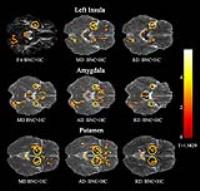 |
95 |
Assessment of brain structural abnormalities and the correlation
with inhibitory control in betel nut chewers with DTI 
Te-Wei Kao1, Ming-Chou Ho2, and
Jun-Cheng Weng1,3
1Department of Medical Imaging and Radiological
Sciences, Chung Shan Medical University, Taichung, Taiwan, 2Department
of Psychology, Chung Shan Medical University, Taichung,
Taiwan,3Department of Medical Imaging, Chung Shan
Medical University Hospital, Taichung, Taiwan
Betel nut is one of the common addictive substances in many
countries. The brain influence of cocaine, alcohol, and
tobacco cigarette have been studied by several studies.
However, only few studies focused on the brain influence of
betel nut, and most of them used fMRI or PET. Thus, our
study aim was to use diffusion tensor imaging (DTI) to
evaluate the impact of neurological structure of white
matter caused by betel nut. The brain structural differences
between the betel nut chewers and healthy controls and the
correlation with inhibitory control were also discussed. Our
results pointed out the significant neurological structural
differences in the insula, amygdala and putamen of DTI
indices between the betel nut chewers and healthy controls.
|
|
3101.
 |
96 |
Assessment of pharmacotherapy effects on APP/PS1 mice brain by
Diffusion Spectrum Imaging 
Chih-Hsien Tseng1,2, Yu-Jen Chen1, and
Wen-Yih Isaac Tseng1,2,3,4
1Institute of Medical Device and Imaging,
National Taiwan University College of Medicine, Taipei,
Taiwan, 2Institute
of Biomedical Engineering, National Taiwan University
College of Medicine, Taipei, Taiwan, 3Graduate
Institute of Brain and Mind Sciences, National Taiwan
University College of Medicine, Taipei, Taiwan, 4Molecular
Imaging Center, National Taiwan University, Taipei, Taiwan
To determine the effects of a novel neuroprotective drug on
white matter integrity in Alzheimer’s disease (AD),
generalized fractional anisotropy (GFA) was assessed in mice
brains using diffusion spectrum imaging (DSI). The mice
included 5 AD mice without medication, 4 AD mice with
medication, and 5 control mice. Comparing with the control
mice, the AD mice without medication showed significantly
increased GFA in the hippocampus and thalamus, whereas the
AD mice with medication showed no significant difference.
Our findings imply that DSI can be used to monitor the drug
effects in AD mice.
|
|

